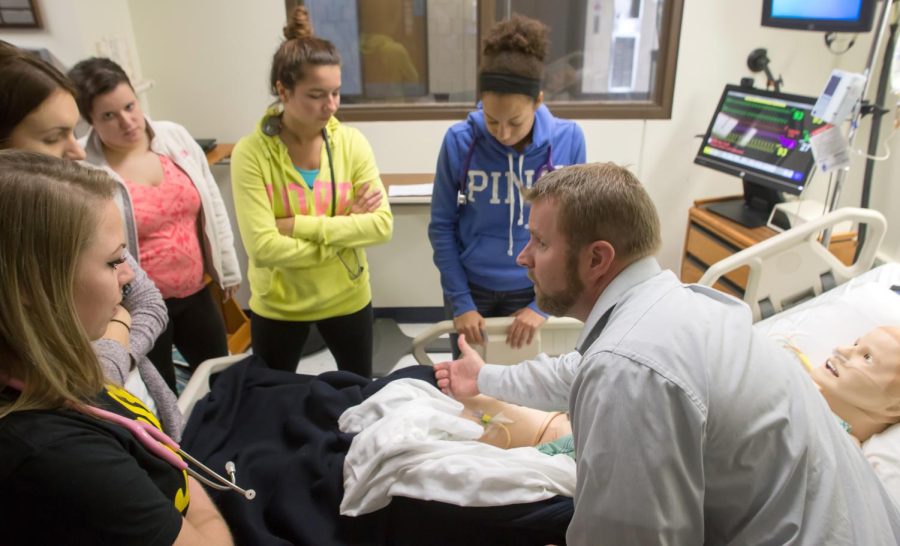Simulation Lab integrates smart-pump IVs, medical robots in classes
Professor Jeremy Jarzembak shows his students how to take a urine sample from a catheter at Henderson on Friday Nov. 6, 2015.
December 2, 2015
The College of Nursing is integrating new medical technology — with smart-pump IVs and SimMan 3G manikins — and practices in classrooms.
This semester, the College of Nursing received a $14,000 grant with the help of simulation lab coordinators and grant writers, including nursing professors Jennifer Shanholtzer and Jeremy Jarzembak. Shanholtzer said the motivation behind writing grant proposals is for introducing future health care professionals to equipment they will use in their career.
“By having the pumps, it makes our simulation lab more realistic,” Shanholtzer said. “(It) also helps our students with using the pumps in a clinical setting.”
Simulation labs
Jarzembak said the Olga A. Mural Simulation Lab in Henderson Hall sees more than 1,400 students each semesters and stressed how important it is for nursing students to have hands-on experience in these labs. Putting students in urgent health care scenarios makes students think, Jarzembak said.
“Key takeaways are exposing students to certain standardized patient conditions, as there is no guarantee that students will experience a certain condition in the hospital setting before they graduate,” Jarzembak said. “In the Simlab, we ensure our students will be exposed to complicated conditions that, when faced with them in a real patient situation, our students will have the experience to know how to handle the situation.”
The simulation lab is equipped with not only smart-pump IVs, but also SimMan 3G manikins controlled by sensors and embedded with computer chips.
The manikins respond with simulations of physiological and neurological reactions to medications students administer to them. The SimMan manikins have blinking eyes, active pulses and lungs that can be adjusted based on the condition the professor wants the students to learn about.
De’Ajah Greene, a senior nursing major, said the experience students receive in the simulation labs allows students to make mistakes and learn from them before working with an actual patient.
“Sim lab is a great way to draw everything together and apply the information (learned in class),” she said. “When you make mistakes, you never will forget (them). It’s really helpful.”
Greene said being able to interact with the other nursing students in the simulation lab makes for a better learning experience overall.
“I like when they allow us to function as one nurse (unit),” she said. “You don’t have to feel like you’re alone. It allows for everyone to get a chance to think and find out what is going on with the patient.”
Smart-pump IVs
Smart-pump IVs are computerized infusion pumps that have the ability to be personalized for each unique patient.
The pumps are equipped with drug libraries that help prevent errors and promote accuracy in the simulation lab and hospitals. Shanholtzer said the IVs used in previous settings didn’t have the safe havens smart-pump IVs have now.
The advanced technology can be seen at a variety of hospitals in Northeast Ohio, including Cleveland Clinic, Lake Health and other Cleveland Clinic affiliates. Shanholtzer said the pumps are fairly new to hospital settings and bringing them to Kent State will be more of an advantage for students to learn.
“Our students are learning the smart-pump technology almost at the same time that nurses are learning this technology,” Shanholtzer said. “It’s a newer piece of equipment that they’re using in the clinical setting, say in the last five years, and our students are right on par with that.”
Jarzembak said he thinks it is a great teaching process that exposes students on how to use smart-pump IV technology at the beginning of their careers.
“The simulation lab provides for a safe environment,” Jarzembak said. “It helps to build confidence.”
Medical robots
Darwin Boyd, assistant professor in the College of Applied Engineering, Sustainability and Technology, is also familiar with students using hands-on technology for their learning experiences.
Boyd is the faculty advisor of Kent State’s Robotics Club, which uses another form of autonomy— the state of existing or acting separately from others, according to Webster’s Dictionary—similar to SimMan 3G manikins. Boyd said the presence of robots will be increasing in medical settings, as well as helping students who can’t physically attend school by showing up in their places via live camera feeds.
“Robots are important,” Boyd said. “There are some students (who) go to school as a telepresence robot because of health conditions. That provides a lot of opportunity.”
Boyd said although the students in the robotics team don’t work with medical robots, they do create robots for competitions that communicate on their own like the manikins used in the simulation lab.
“The robot has to be aware of where it is,” Boyd said. “It has to be able to run around on the simulated surface (and) be able to do a lot of that stuff by itself. That kind of awareness and sensors and so forth can also be applied in the medical field.”
Boyd said it’s important to incorporate the technology among different groups of students for learning purposes and to bring all subjects together.
“There’s the technical stuff,” he said. “Then there’s (a variety) of different areas. You have communications …mechanical and …programming. You have to be able to tie all of that together.”
Toni Hunt is the education, health and human services reporter for The Kent Stater. Contact her at [email protected].

























